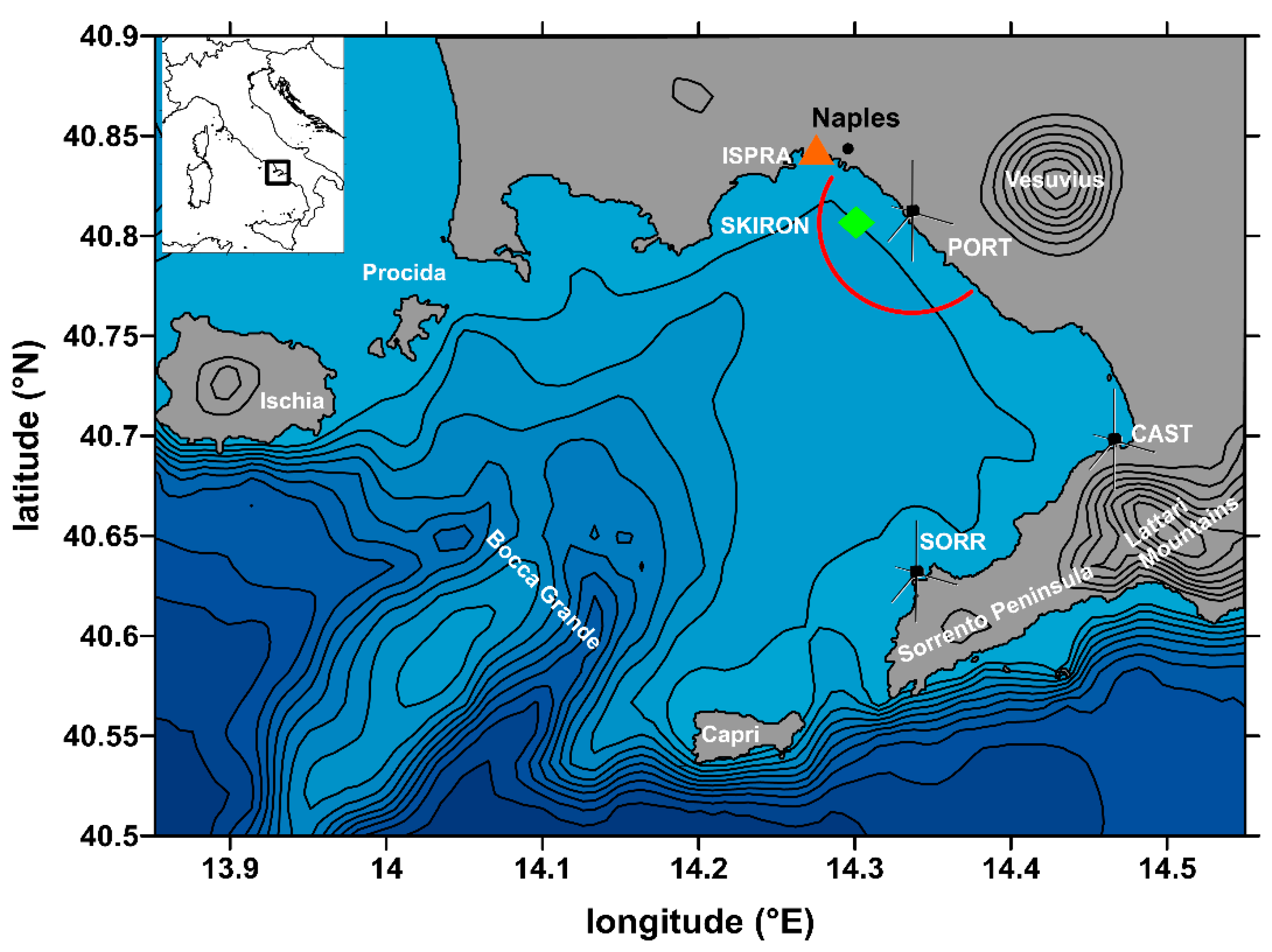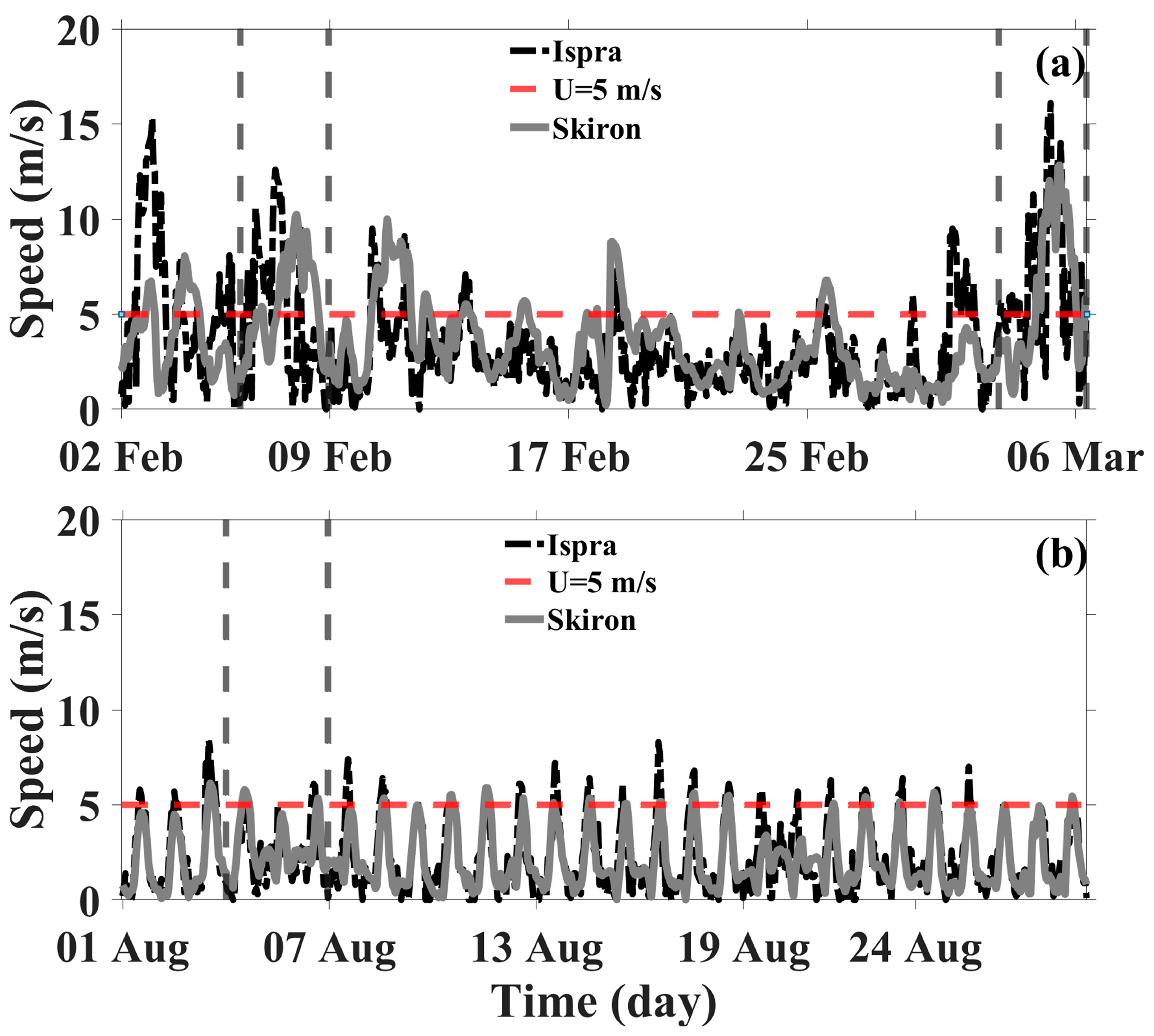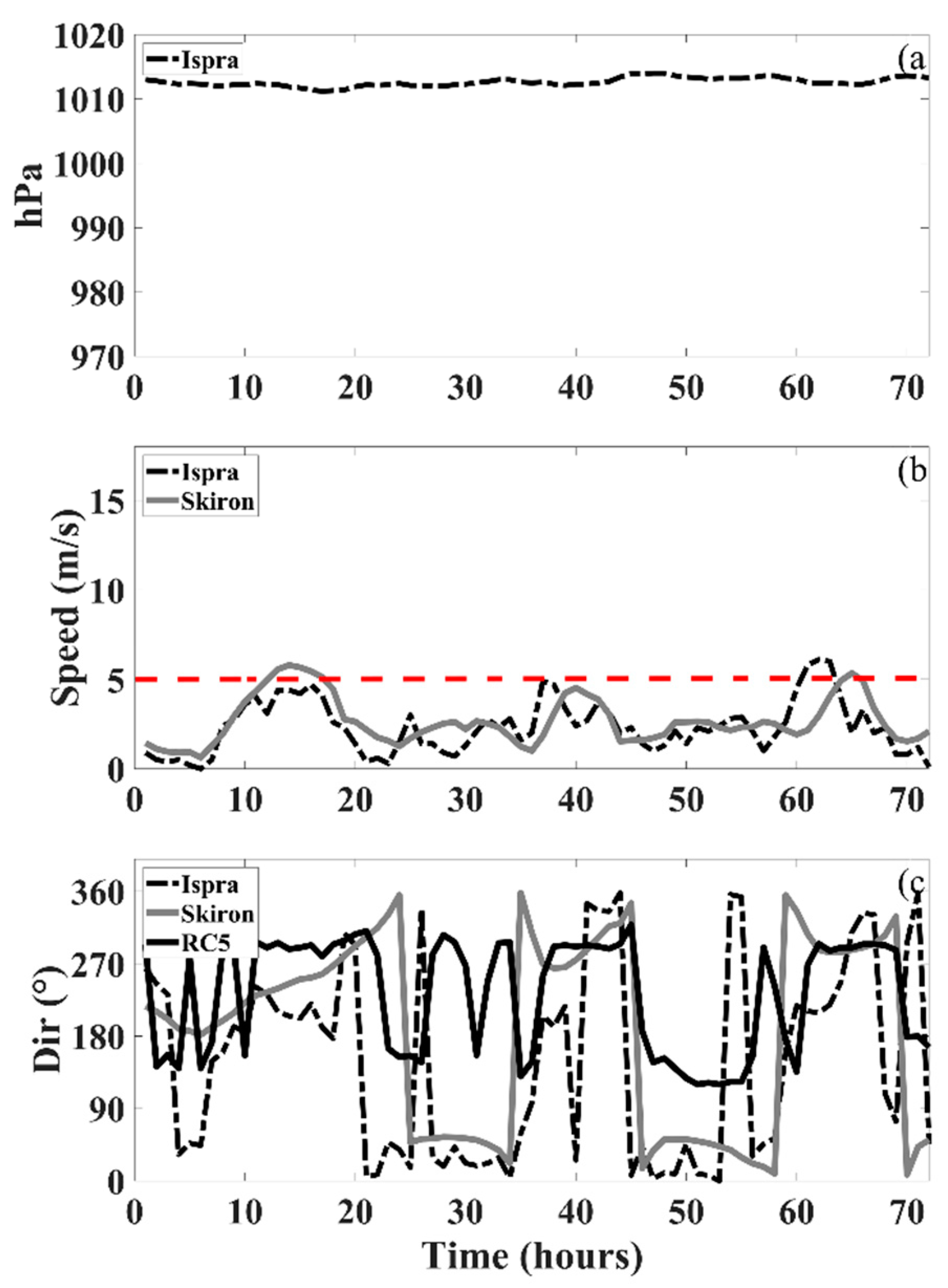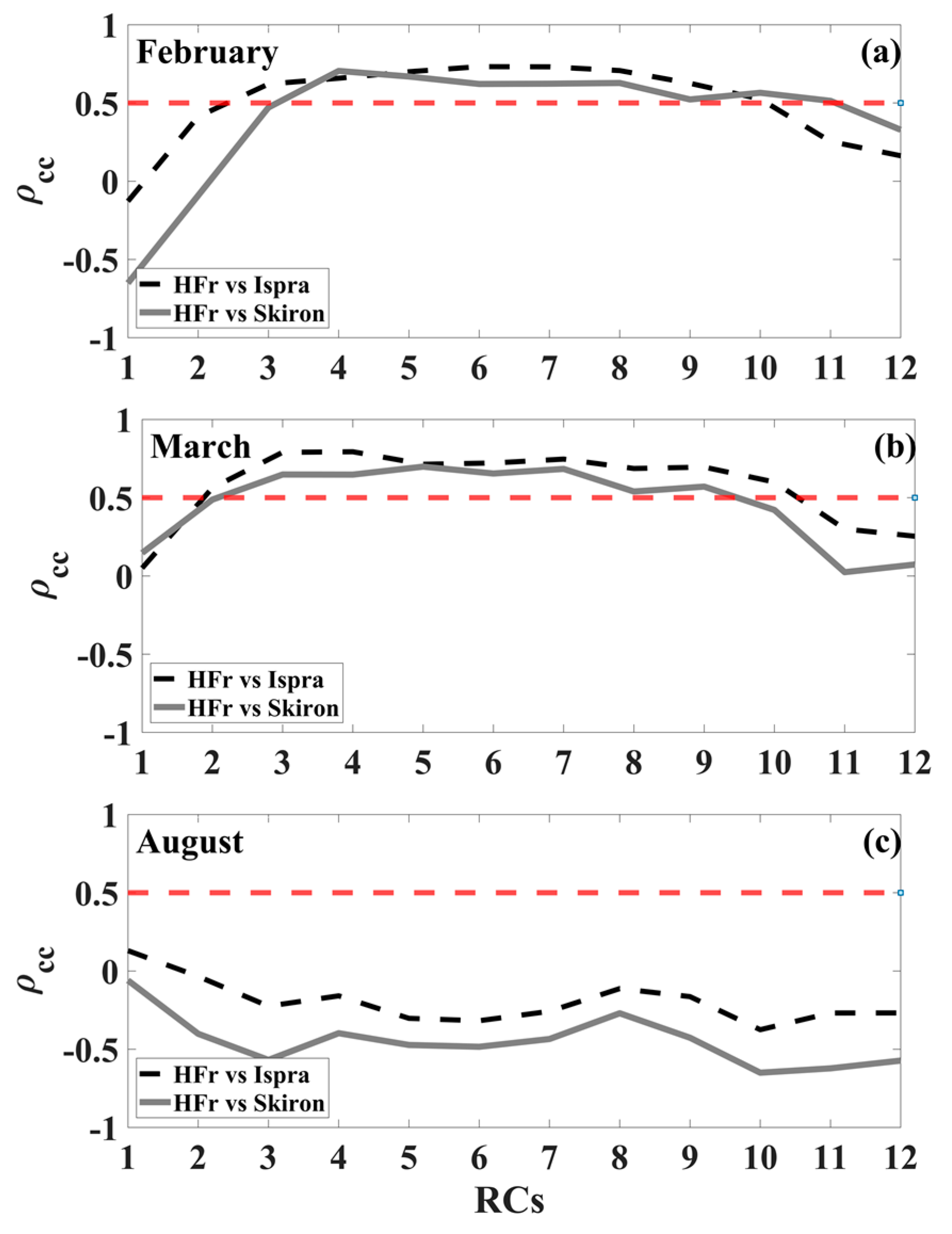Wind Direction Data from a Coastal HF Radar System in the Gulf of Naples (Central Mediterranean Sea)
Abstract
:1. Introduction
2. Study Area Overview
3. Materials and Methods
4. Results
Wind Direction under Different Wind Conditions
5. Discussion
6. Conclusions
Author Contributions
Funding
Institutional Review Board Statement
Informed Consent Statement
Data Availability Statement
Acknowledgments
Conflicts of Interest
References
- Rubio, A.; Mader, J.; Corgnati, L.; Mantovani, C.; Griffa, A.; Novellino, A.; Quentin, C.; Wyatt, L.; Schulz-Stellenfleth, J.; Horstmann, J.; et al. HF radar activity in European coastal seas: Next steps toward a pan-European HF radar network. Front Mar. Sci. 2017, 4, 8. [Google Scholar] [CrossRef] [Green Version]
- Roarty, H.; Cook, T.; Hazard, L.; George, D.; Harlan, J.; Cosoli, S.; Wyatt, L.; Alvarez Fanjul, E.; Terrill, E.; Otero, M.; et al. The global high frequency radar network. Front. Mar. Sci. 2019, 6, 164. [Google Scholar] [CrossRef]
- Wyatt, L.R. Wave mapping with HF radar. In Proceedings of the 2011 IEEE/OES—Current, Waves and Turbulence Measurements (CWTM), Monterey, CA, USA, 20–23 March 2011; p. 2. [Google Scholar] [CrossRef]
- Lipa, B.; Nyden, B. Directional wave information from the SeaSonde. IEEE J. Ocean. Eng. 2005, 30, 221–231. [Google Scholar] [CrossRef] [Green Version]
- Gurgel, K.-W.; Antonischki, G.; Essen, H.-H.; Schlick, T. Wellen Radar WERA: A new ground-wave HF radar for ocean remote sensing. Coast. Eng. 1999, 37, 219–234. [Google Scholar] [CrossRef]
- Saviano, S.; Kalampokis, A.; Zambianchi, E.; Uttieri, M. A year-long assessment of wave measurements retrieved from an HF radar network in the Gulf of Naples (Tyrrhenian Sea, Western Mediterranean Sea). J. Oper. Oceanogr. 2019, 12, 1–15. [Google Scholar] [CrossRef]
- Orasi, A.; Picone, M.; Drago, A.; Capodici, F.; Gauci, A.; Nardone, G.; Inghilesi, R.; Azzopardi, J.; Galea, A.; Ciraolo, G.; et al. HF Radarfor Wind Waves Measurements in the Malta-Sicily Channel. Measurements 2018, 128, 446–454. [Google Scholar]
- Lorente, P.; Lin-Ye, J.; García-León, M.; Reyes, E.; Fernandes, M.; Sotillo, M.G.; Espino, M.; Ruiz, M.I.; Gracia, V.; Perez, S.; et al. On the performance of high frequency radar in the western Mediterranean: During the record-breaking storm Gloria. Front. Mar. Sci. 2021, 8, 645762. [Google Scholar] [CrossRef]
- Basañez, A.; Lorente, P.; Montero, P.; Álvarez-Fanjul, E.; Pérez-Muñuzuri, V. Quality assessment and practical interpretation of the wave parameters estimated by HF Radars in NW Spain. Remote. Sens. 2020, 12, 598. [Google Scholar] [CrossRef] [Green Version]
- Long, A.E.; Trizna, D.B. Measurements and Preliminary Interpretation of hf Radar Doppler Spectra from the Sea-Echo of an Atlantic Storm; Naval Research Laboratory: Washinghton, DC, USA, 1972; p. 7456. [Google Scholar]
- Zeng, Y.; Zhou, H.; Lai, Y.; Wen, B. Wind-direction mapping with a modified wind spreading function by broad-beam high-frequency radar. IEEE Geosci. Remote. Sens. Lett. 2018, 15, 679–683. [Google Scholar] [CrossRef]
- Gurgel, K.W.; Essen, H.H.; Schlick, T. An empirical method to derive ocean waves from second-order Bragg scattering: Prospects and limitations. IEEE J. Ocean. Eng. 2006, 31, 804–811. [Google Scholar] [CrossRef]
- Heron, M.L. Applying a unified directional wave spectrum to the remote sensing of wind wave directional spreading. Can. J. Remote. Sens. 2002, 28, 346–353. [Google Scholar] [CrossRef]
- Huang, W.; Gill, E.; Wu, S.; Wen, B.; Yang, Z.; Hou, J. Measuring surface wind direction by monostatic HF ground-wave radar at the eastern China sea. IEEE J. Ocean. Eng. 2004, 29, 1032–1037. [Google Scholar] [CrossRef]
- Chu, X.; Zhang, J.; Ji, Y.; Wang, Y.; Yang, L. Extraction of wind direction from the HF hybrid sky-surface wave radar sea echoes. IEEE Aerosp. Electron. Syst. Mag. 2018, 33, 42–47. [Google Scholar] [CrossRef]
- Shen, W.; Gurgel, K.W.; Voulgaris, G.; Schlick, T.; Stammer, D. Wind-speed inversion from HF radar first-order backscatter signal. Ocean Dyn. 2012, 62, 105–121. [Google Scholar] [CrossRef]
- Hisaki, Y. Sea surface wind correction using HF ocean radar and its impact on coastal wave prediction. J. Atmos. Ocean. Technol. 2017, 34, 2001–2020. [Google Scholar] [CrossRef]
- Kirincich, A. Remote sensing of the surface wind field over the coastal ocean via direct calibration of HF radar backscatter power. J. Atmospheric Ocean. Technol. 2016, 33, 1377–1392. [Google Scholar] [CrossRef]
- Zeng, Y.; Zhou, H.; Roarty, H.; Wen, B. Wind speed inversion in high frequency Radar based on neural network. Int. J. Antennas Propag. 2016, 2016, 1–8. [Google Scholar] [CrossRef] [Green Version]
- Lipa, B.; Barrick, D.; Alonso-Martirena, A.; Fernandes, M.; Ferrer, M.I.; Nyden, B. Brahan project high frequency radar ocean measurements: Currents, winds, waves and their interactions. Remote. Sens. 2014, 6, 12094–12117. [Google Scholar] [CrossRef] [Green Version]
- Shen, W.; Gurgel, K.-W. Wind direction inversion from narrow-beam HF Radar backscatter signals in low and high wind conditions at different radar frequencies. Remote. Sens. 2018, 10, 1480. [Google Scholar] [CrossRef] [Green Version]
- Wyatt, L.R.; Green, J.J.; Middleditch, A.; Moorhead, M.D.; Howarth, J.; Holt, M.; Keogh, S. Operational wave, current, and wind measurements with the Pisces HF Radar. IEEE J. Ocean. Eng. 2006, 31, 819–834. [Google Scholar] [CrossRef]
- Wyatt, L.R. A comparison of scatterometer and HF radar wind direction measurements. J. Oper. Oceanogr. 2018, 11, 54–63. [Google Scholar] [CrossRef]
- Heron, M.L.; Prytz, A. Wave height and wind direction from the HF coastal ocean surface radar. Can. J. Remote. Sens. 2002, 28, 385–393. [Google Scholar] [CrossRef]
- Long, A.; Trizna, D. Mapping of North Atlantic winds by HF radar sea backscatter interpretation. IEEE Trans. Antennas Propag. 1973, 21, 680–685. [Google Scholar] [CrossRef]
- Falco, P.; Buonocore, B.; Cianelli, D.; De Luca, L.; Giordano, A.; Iermano, I.; Kalampokis, A.; Saviano, S.; Uttieri, M.; Zambardino, G.; et al. Dynamics and sea state in the Gulf of Naples: Potential use of high-frequency radar data in an operational oceanographic context. J. Oper. Oceanogr. 2016, 9, S33–S45. [Google Scholar] [CrossRef] [Green Version]
- Cianelli, D.; Falco, P.; Iermano, I.; Mozzillo, P.; Uttieri, M.; Buonocore, B.; Zambardino, G.; Zambianchi, E. Inshore/o shore water exchange in the Gulf of Naples. J. Mar. Syst. 2015, 145, 37–52. [Google Scholar] [CrossRef]
- Uttieri, M.; Cianelli, D.; Nardelli, B.B.; Buonocore, B.; Falco, P.; Colella, S.; Zambianchi, E. Multiplatform observation of the surface circulation in the Gulf of Naples (Southern Tyrrhenian Sea). Ocean Dyn. 2011, 61, 779–796. [Google Scholar] [CrossRef]
- Cianelli, D.; D’Alelio, D.; Uttieri, M.; Sarno, D.; Zingone, A.; Zambianchi, E.; d’Alcalà, M.R. Disentangling physical and biological drivers of phytoplankton dynamics in a coastal system. Sci. Rep. 2017, 7, 15868. [Google Scholar] [CrossRef] [Green Version]
- Bagaglini, L.; Falco, P.; Zambianchi, E. Eddy detection in HF radar-derived surface currents in the Gulf of Naples. Remote. Sens. 2019, 12, 97. [Google Scholar] [CrossRef] [Green Version]
- Saviano, S.; Cianelli, D.; Zambianchi, E.; Conversano, F.; Uttieri, M. An integrated reconstruction of the multiannual wave pattern in the Gulf of Naples (South-Eastern Tyrrhenian Sea, Western Mediterranean Sea). J. Mar. Sci. Eng. 2020, 8, 372. [Google Scholar] [CrossRef]
- Saviano, S.; De Leo, F.; Besio, G.; Zambianchi, E.; Uttieri, M. HF Radar Measurements of Surface Waves in the Gulf of Naples (Southeastern Tyrrhenian Sea): Comparison With Hindcast Results at Different Scales. Front. Mar. Sci. 2020, 7. [Google Scholar] [CrossRef]
- de Leo, F.; Besio, G.; Saviano, S.; Zambianchi, E.; Uttieri, M. Evaluation of HF-radar wave measures in the Gulf of Naples. In Proceedings of the IMEKO TC19 InternationalWorkshop on Metrology for the Sea: Learning to Measure Sea Health Parameters (MetroSea 2019), Genova, Italy, 3–5 October 2019. [Google Scholar]
- Saviano, S.; Cianelli, D.; Zambianchi, E.; Conversano, F.; Uttieri, M. Multiple year characterization of the wave field in the Gulf of Naples by multi-platform measurements. In Proceedings of the IMEKO TC19 InternationalWorkshop on Metrology for the Sea: Learning to Measure Sea Health Parameters (MetroSea 2019), Genova, Italy, 3–5 October 2019. [Google Scholar]
- Zecchetto, S.; Cappa, C. The spatial structure of the Mediterranean Sea winds revealed by ERS-1 scatterometer. Int. J. Remote. Sens. 2001, 22, 45–70. [Google Scholar] [CrossRef]
- Lavagnini, A.; Sempreviva, A.M.; Transerici, C.; Accadia, C.; Casaioli, M.; Mariani, S.; Speranza, A. Offshore wind climatology over the Mediterranean basin. Wind. Energy 2006, 9, 251–266. [Google Scholar] [CrossRef]
- Mesinger, F. A method of construction of second order accuracy difference schemes permitting no false two-grid interval wave in the height field. Tellus 1973, 25, 444–458. [Google Scholar] [CrossRef]
- Schaeffer, A.; Garreau, P.; Molcard, A.; Fraunié, P.; Seity, Y. Influence of high resolution wind forcing on hydrodynamic modeling of the Gulf of Lions. Ocean Dyn. 2011, 61, 1823–1844. [Google Scholar] [CrossRef]
- Kara, A.B.; Wallcraft, A.J.; Huelbert, H.E. A correction for land contamination of atmospheric variables near land-sea boundaries. J. Phys. Oceanogr. 2007, 37, 803–818. [Google Scholar] [CrossRef] [Green Version]
- Amante, C.; Eakins, B.W. ETOPO1 1 Arc-Minute Global Relief Model: Procedures, Data Sources and Analysis; NOAA Technical Memorandum NESDIS NGDC-24; National Geophysical Data Center, NOAA: Boulder, CO, USA, 2009. [CrossRef]
- Menna, M.; Mercatini, A.; Uttieri, M.; Buonocore, B.; Zambianchi, E. Wintertime transport processes in the Gulf of Naples investigated by HF radar measurements of surface currents. Nuovo Cimento C 2007, 30, 605–622. [Google Scholar]
- Prati, M.V.; Costagliola, M.A.; Quaranta, F.; Murena, F. Assessment of ambient air quality in the port of Naples. J. Air Waste Manag. Assoc. 2015, 65, 970–979. [Google Scholar] [CrossRef] [PubMed] [Green Version]
- Montuori, A.; de Ruggiero, P.; Migliaccio, M.; Pierini, S.; Spezie, G. X-band COSMO- SkyMedc wind field retrieval, with application to coastal circulation modeling. Ocean Sci. 2013, 9, 121–132. [Google Scholar] [CrossRef] [Green Version]
- de Ruggiero, P. 2013: A high-resolution ocean circulation model of the Gulf of Naples and adjacent areas. Nuovo Cim. C 2013, 36, 143–150. [Google Scholar]
- Hatzaki, M.; Flocas, H.A.; Simmonds, I.; Kouroutzoglou, J.; Keay, K.; Rudeva, I. Seasonal aspects of an objective climatology of anticyclones affecting the Mediterranean. J. Clim. 2014, 27, 9272–9289. [Google Scholar] [CrossRef]
- de Ruggiero, P.; Esposito, G.; Napolitano, E.; Iacono, R.; Pierini, S.; Zambianchi, E. Modelling the marine circulation of the Campania coastal system (Tyrrhenian Sea) for the year 2016: Analysis of the dynamics. J. Mar. Syst. 2020, 210, 103388. [Google Scholar] [CrossRef]
- de Ruggiero, P.; Napolitano, E.; Iacono, R.; Pierini, S.; Spezie, G. A baroclinic coastal trapped wave event in the Gulf of Naples (Tyrrhenian Sea). Ocean Dyn. 2018, 68, 1683–1694. [Google Scholar] [CrossRef]
- Castagno, P.; De Ruggiero, P.; Pierini, S.; Zambianchi, E.; De Alteris, A.; De Stefano, M.; Budillon, G. Hydrographic and dynamical characterisation of the Bagnoli-Coroglio Bay (Gulf of Naples, Tyrrhenian Sea). Chem. Ecol. 2020, 36, 598–618. [Google Scholar] [CrossRef]
- De Maio, A.; Moretti, M.; Sansone, E.; Spezie, G.; Vultaggio, M. Outline of marine currents in the Bay of Naples and some considerations on pollutant transport. II Nuovo Cimento C 1985, 8, 955–969. [Google Scholar] [CrossRef]
- Cianelli, D.; Uttieri, M.; Buonocore, B.; Falco, P.; Zambardino, G.; Zambianchi, E. Dynamics of a Very Special Mediterranean Coastal Area: The Gulf of Naples, in Mediterranean Ecosystems: Dynamics, Management and Conservation; Williams, G., Ed.; Nova Science Publishers: New York, NY, USA, 2012; pp. 129–150. [Google Scholar]
- Lipa, B.; Daugharty, M.; Fernandes, M.; Barrick, D.; Alonso-Martinera, A.; Roarty, H.; Whelan, C. Developments in compact HF-radar ocean wave measurement. Adv. Sens. Rev. 2018, 5, 469–495. [Google Scholar]
- Laws, K.; Paduan, J.D.; Vesecky, J. Estimation and assessment of errors related to antenna pattern distortion in CODAR SeaSonde high-frequency radar ocean current measurements. J. Atmospheric Ocean. Technol. 2010, 27, 1029–1043. [Google Scholar] [CrossRef] [Green Version]
- Lipa, B.; Nyden, B.; Barrick, D.; Kohut, J. HF radar sea-echo from shallow water. Sensors 2008, 8, 4611–4635. [Google Scholar] [CrossRef]
- Mesinger, F. Forward–backward scheme and its use in a limited area model. Contrib. Atmos. Phys. 1977, 50, 200–210. [Google Scholar]
- Janjic, Z.I. A stable centered difference scheme free of the two-grid-interval noise. Mon. Wea. Rev. 1974, 102, 319–323. [Google Scholar] [CrossRef] [Green Version]
- Janjic, Z.I. Forward–backward scheme modified to prevent two-grid-interval noise and its application in sigma coordinate models. Contrib. Atmos. Phys. 1979, 52, 69–84. [Google Scholar]
- Papadopoulos, A.; Katsafados, P.; Kallos, G. Regional weather forecasting for marine application. GAOS 2002, 8, 219–237. [Google Scholar]
- De Ruggiero, P.; Napolitano, E.; Iacono, R.; Pierini, S. A high-resolution modelling study of the circulation along the Campania coastal system, with a special focus on the Gulf of Naples. Cont. Shelf Res. 2016, 122, 85–101. [Google Scholar] [CrossRef]
- Ranalli, M.; Lagona, F.; Picone, M.; Zambianchi, E. Segmentation of sea current fields by cylindrical hidden Markov models: A composite likelihood approach. J. R. Stat. Soc. Ser. C Appl. Stat. 2017, 67, 575–598. [Google Scholar] [CrossRef]
- Bowers, J.; Morton, I.; Mould, G. Directional statistics of the wind and waves. Appl. Ocean Res. 2000, 22, 13–30. [Google Scholar] [CrossRef]
- Fisher, N.I.; Lee, A.J. A correlation-coefficient for circular data. Biometrika 1983, 70, 327–332. [Google Scholar] [CrossRef]
- Berens, P. CircStat: A Matlab Toolbox for Circular Statistics. J. Stat. Softw. 2009, 31. Available online: http://www.jstatsoft.org/v31/i10 (accessed on 23 November 2017). [CrossRef] [Green Version]
- Ludeno, G.; Uttieri, M. Editorial for Special Issue “Radar technology for coastal areas and open sea monitoring”. J. Mar. Sci. Eng. 2020, 8, 560. [Google Scholar] [CrossRef]
- Paduan, J.D.; Washburn, L. High-Frequency radar observations of ocean surface currents. Annu. Rev. Mar. Sci. 2013, 5, 115–136. [Google Scholar] [CrossRef] [Green Version]
- Iermano, I.; Moore, A.; Zambianchi, E. Impacts of a 4-dimensional variational data assimilation in a coastal ocean model of southern Tyrrhenian Sea. J. Mar. Syst. 2016, 154, 157–171. [Google Scholar] [CrossRef]
- Hardman, R.L.; Wyatt, L.R. Inversion of HF radar Doppler spectra using a neural network. J. Mar. Sci. Eng. 2019, 7, 255. [Google Scholar] [CrossRef] [Green Version]
- Mathew, T.E.; Deo, M.C. Inverse estimation of wind from the waves measured by high-frequency radar. Int. J. Remote. Sens. 2011, 33, 2985–3003. [Google Scholar] [CrossRef]








| Comparisons | Periods | Total Number of Entries (h) | Number of Entries above Threshold (U > 5 m/s) | RMSE (°) (U > 5 m/s) | |
|---|---|---|---|---|---|
| HFr-ISPRA | 6 February–6 March 2009 | 778 | 153 | 43.5° | 0.82 |
| HFr-SKIRON/Eta | 6 February–6 March 2009 | 778 | 178 | 52.4° | 0.29 |
| HFr-ISPRA | August 2009 | 672 | 70 | 63.8° | 0.26 |
| HFr-SKIRON/Eta | August 2009 | 672 | 42 | 65.2° | 0.53 |
| Comparisons | Periods | Observation Number (h) | RMSE (°) | ϴ (°) | |
|---|---|---|---|---|---|
| HFr-ISPRA | 6–8 February 2009 | 72 | 63.5° | −8.25° | 0.70 |
| HFr-SKIRON/Eta | 6–8 February 2009 | 72 | 55.2° | −14.17° | 0.67 |
| HFr-ISPRA | 3–6 March 2009 | 72 | 55.1° | −15.16° | 0.71 |
| HFr-SKIRON/Eta | 3–6 March 2009 | 72 | 53.7° | −15.69° | 0.65 |
| HFr-ISPRA | 4–6 August 2009 | 72 | 99.8° | 94.17° | −0.30 |
| HFr-SKIRON/Eta | 4–6 August 2009 | 72 | 88.5° | 33.72° | −0.47 |
Publisher’s Note: MDPI stays neutral with regard to jurisdictional claims in published maps and institutional affiliations. |
© 2021 by the authors. Licensee MDPI, Basel, Switzerland. This article is an open access article distributed under the terms and conditions of the Creative Commons Attribution (CC BY) license (https://creativecommons.org/licenses/by/4.0/).
Share and Cite
Saviano, S.; Esposito, G.; Di Lemma, R.; de Ruggiero, P.; Zambianchi, E.; Pierini, S.; Falco, P.; Buonocore, B.; Cianelli, D.; Uttieri, M. Wind Direction Data from a Coastal HF Radar System in the Gulf of Naples (Central Mediterranean Sea). Remote Sens. 2021, 13, 1333. https://doi.org/10.3390/rs13071333
Saviano S, Esposito G, Di Lemma R, de Ruggiero P, Zambianchi E, Pierini S, Falco P, Buonocore B, Cianelli D, Uttieri M. Wind Direction Data from a Coastal HF Radar System in the Gulf of Naples (Central Mediterranean Sea). Remote Sensing. 2021; 13(7):1333. https://doi.org/10.3390/rs13071333
Chicago/Turabian StyleSaviano, Simona, Giovanni Esposito, Roberta Di Lemma, Paola de Ruggiero, Enrico Zambianchi, Stefano Pierini, Pierpaolo Falco, Berardino Buonocore, Daniela Cianelli, and Marco Uttieri. 2021. "Wind Direction Data from a Coastal HF Radar System in the Gulf of Naples (Central Mediterranean Sea)" Remote Sensing 13, no. 7: 1333. https://doi.org/10.3390/rs13071333
APA StyleSaviano, S., Esposito, G., Di Lemma, R., de Ruggiero, P., Zambianchi, E., Pierini, S., Falco, P., Buonocore, B., Cianelli, D., & Uttieri, M. (2021). Wind Direction Data from a Coastal HF Radar System in the Gulf of Naples (Central Mediterranean Sea). Remote Sensing, 13(7), 1333. https://doi.org/10.3390/rs13071333









